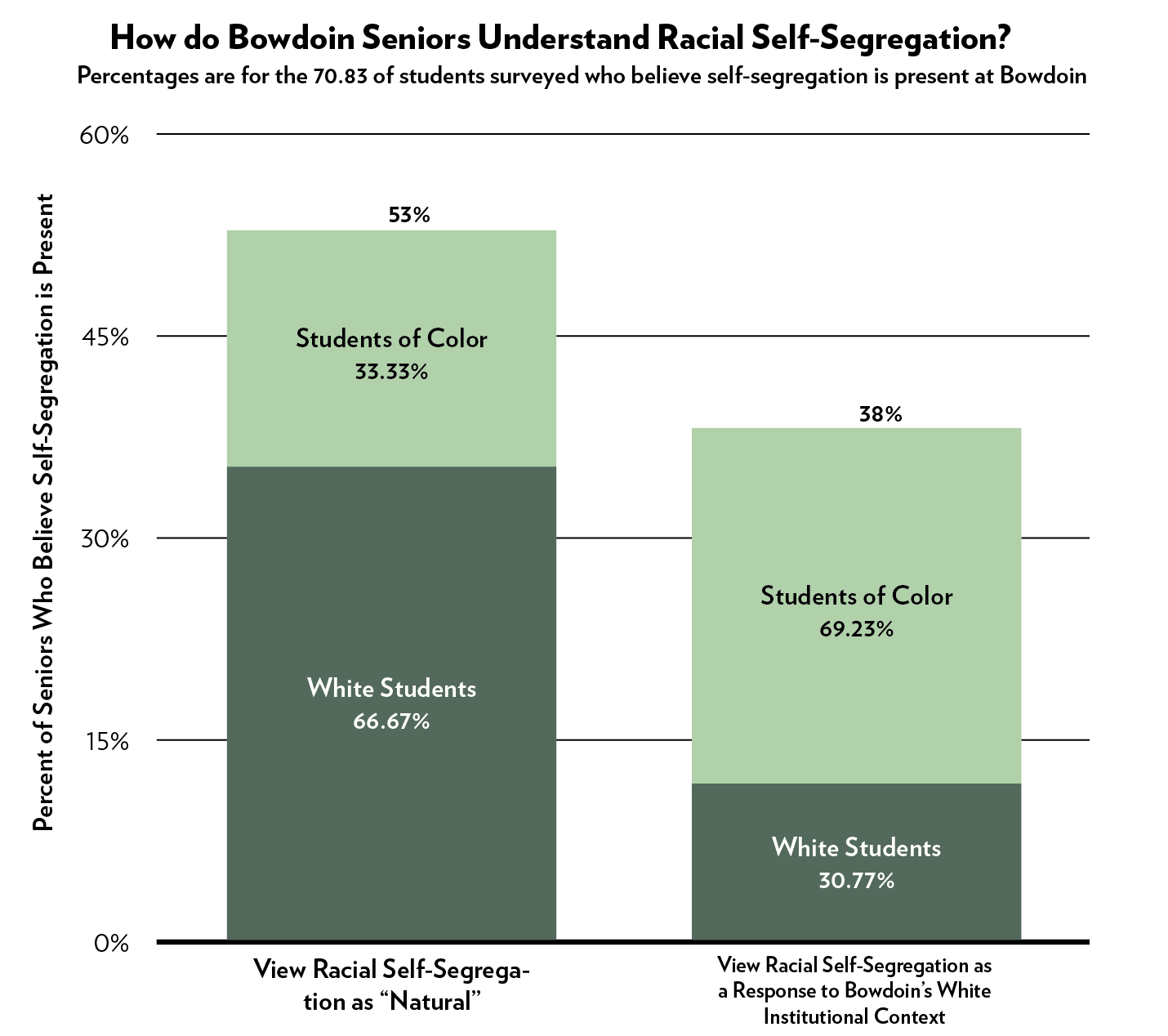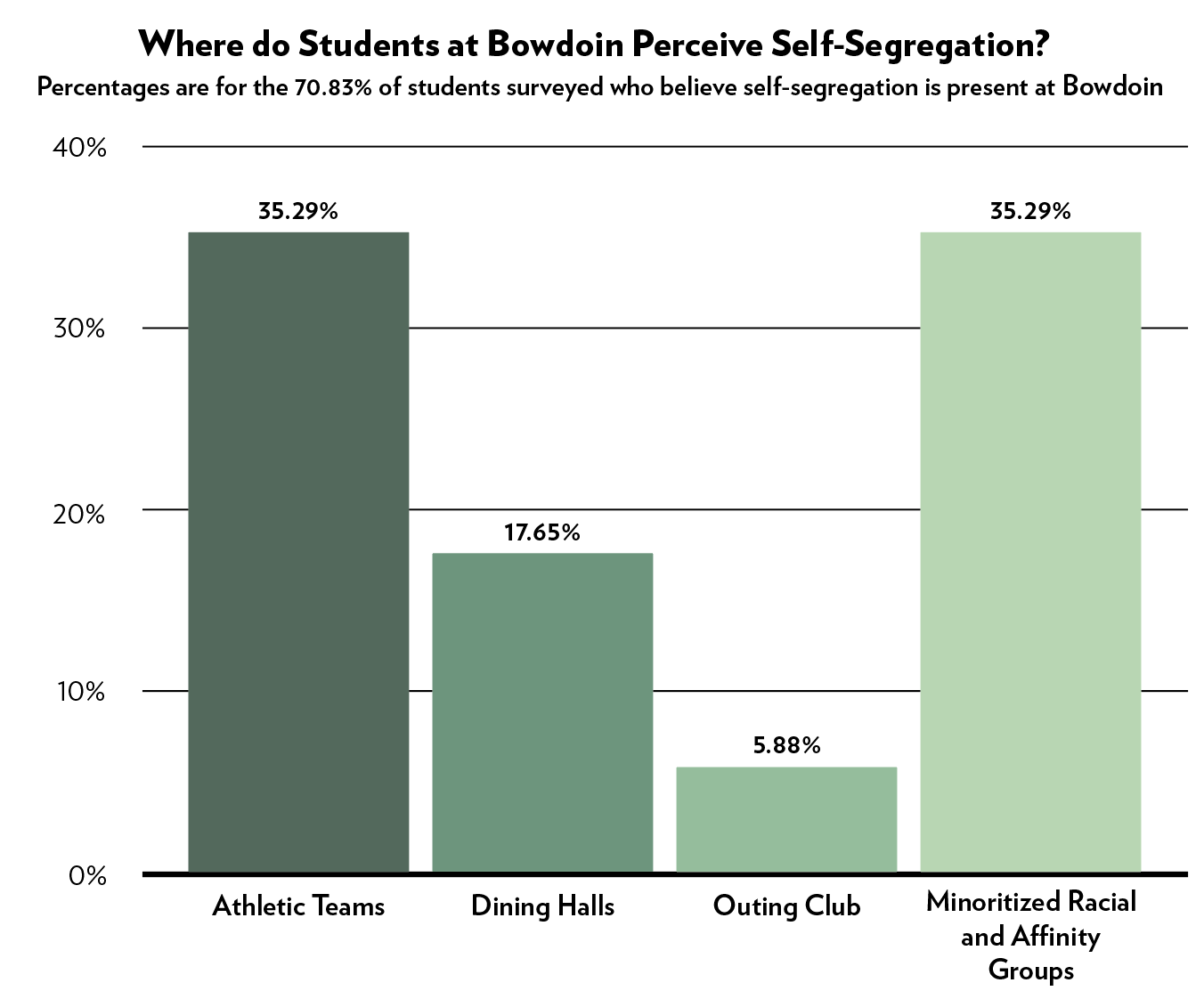Dorm(ant) divergence: unequal understandings of housing, self-segregation and inequity
Students from the Diversity in Higher Eduction seminar share their research
March 30, 2018
When we applied to Bowdoin, we checked boxes on the Common App designating our “official” identities, which suggest to Admissions how we might add to “diversity” on campus. But what happened next, after arriving on campus? Once we began taking classes and found friends, how did we come to understand our identities here, if at all? How did we reckon with difference?
Last October, a group of seniors and juniors in Diversity in Higher Education, a sociology seminar taught by Professor Ingrid Nelson, interviewed 57 Bowdoin seniors in search of answers as part of our research project, Understanding Diversity. In interviews that lasted from one to three hours, respondents shared their stories from childhood through high school, brought us through each year of their Bowdoin experience, reflected on social class, race, gender, and sexuality, and explained their understandings of campus diversity, controversies surrounding racial bias and incidents of gender violence.
Unsurprisingly, diversity matters for all of us at this school—but with this comes the challenge of defining what we mean by “diversity.” We have brought together analyses of 48 student interviews to explore the state of diversity at Bowdoin and to start answering important questions. This week’s piece will focus on housing and self-segregation. Over the coming three weeks, we will share data on academics, campus climate and student conceptions of diversity. We will direct attention to campus structures, explore how student actions and inactions shape this community, and raise questions about what “diversity” really looks like on this campus, beyond admissions numbers.
We share these snapshots of our research findings, based on the real and personal experiences of our peers, in hopes of starting meaningful conversations about difference at Bowdoin without burdening the students constantly facing inquiry.
We gave considerable thought to the demographics of our respondents, intentionally over-representing students of color to gain insight into the experiences of the huge multitude of identities within that category, and because we were interested in their experiences at this predominantly white institution. We sent email solicitations to 111 randomly-selected seniors, with a response rate of 51 percent. Women of color had the highest response rate (78 percent) and white men had the lowest response rate (41 percent). The sample is about 50 percent men, 50 percent women, and includes one person who identifies as non-binary. This is representative of the senior class. The sample is about 50 percent white students and 50 percent students of color, compared to the senior class which is 69 percent white students and 31 percent students of color. Although the latter is using an oversimplified category, we will refrain from more specificity to protect confidentiality. While 57 interviews were conducted, due to time constraints, 48 total respondents are included in this analysis. Throughout the interview and analysis processes, student identities and data have been kept confidential. As we will discuss later in more detail, higher response rates among women and people of color point to a general disparity in who takes on the work of discussing issues of diversity and inclusion.
Our interviews confirmed current sociological literature: the burden of this work is largely carried by the students who actively feel the effects of elite higher education’s white, upper-class history. Bowdoin has become more racially diverse since its beginnings as an institution for white men of elite backgrounds—campus is now 15 percent less white than in the 2001-2002 academic year—but it still remains a predominantly white institution in the whitest state in the United States. More importantly, the effects of that history remain prominent for students in their academic, extracurricular, and social lives; our interviews show a disparity in the ways students define and experience diversity at Bowdoin. Many students of color, first-generation students, low-income students and people of other historically marginalized identities tend to think about diversity more frequently and more personally than do most white students of wealthy backgrounds.
As we assess the situation facing us at this moment, we encourage you to challenge what has become habitual and what feels ordinary at Bowdoin. We ask that you consider where you fit in this conversation, where you stand and what brings you to feel that way. More importantly, we implore you to act on those thoughts; paired with your action, our data can facilitate the shift from conversations and thoughts to concrete change that contributes to the greater task of dismantling racism.
•••
In February, Dean of Student Affairs Tim Foster emailed students, urging them to take advantage of the diversity on campus when picking housing for next year. Dean Foster’s plea to “Mix it up!” points to a reality at Bowdoin: call it cliquey, exclusive, or segregated, students tend to share social spaces with people “like them.”
To seniors—several years out from being placed on intentionally diverse floors—Dean Foster’s recognition that students spend more time with peers like them than different from them is no shock. More than 70 percent of the seniors we interviewed felt that students self-segregate by race.
How do student groups separate? Why? And, why does it matter?
Many students make their first friends at Bowdoin in shared spaces—roommates or floormates. Housing arrangements are the primary structure shaping friendship circles during respondents’ first year. While first-year floors are not proportionally representative of our racial breakdown on campus because more students of color elect to live in chem- free housing (in our data, 31 percent of students of color elected chem-free floors versus 13 percent of white students), first-year floors foster relationships among students that are more racially diverse.
With time, however, extracurricular activities become more salient. Athletics, for example, are a dominant force in the social scene and, due to the whiteness of athletic teams, often solidify friendships solely among white students. Of the respondents who said students self-segregate, 35 percent mentioned athletic teams and 29 percent mentioned specific non-white racial and affinity groups. Some students of color discussed how they interacted more with white peers their first year, then began to develop friendships with other students of color. One student of color said, “There came a point where I didn’t hang out with my [first-year] floor as much ‘cause I felt like I was forcing it.” She continued, “race became a bigger factor in my social relationships [after my first year].” While mandating housing situations after the first year seems restrictive, our autonomy to select roommates leaves no mechanism in place to combat self-segregation by race in housing.
Most students in our sample expressed a keen awareness of racial segregation on campus. The reasons students provided for this, however, varied.
Over half (53 percent) of the students who felt that students self-segregate discussed it as “natural.” Of these students, two-thirds were white. Explaining this thought, students said things like, “[people] are gonna flock together over time” and “[students] tend to gravitate towards people that look like themselves” and just “happen to be of your race.” One student interpreted this behavior as “natural humanistic instinct.” Reflecting on his housing situation, one white student said “It just happened that almost all the guys I live with are white.” Students who described self-segregation as natural did not address bigger structural factors that explain the homogeneity of social groups. These students feel like they “just happen.” However, as over one third of students explained, racial separation is informed by Bowdoin’s structures and social culture.
Thirty-eight percent adopted a view of segregation on campus that linked it to Bowdoin’s enduring legacy as a historically white and wealthy institution. Most of these respondents (69 percent) were students of color. To these students (all 38 percent), self-segregation was an important strategy for navigating the predominantly white campus. One student suggested the campus, generally, is not welcoming to students of color: “I think a lot of it is on the community to make everyone feel comfortable. And I don’t know if that’s necessarily what’s happening.” Students cited needs for support and understanding as factors that drive students to divide by race. At Bowdoin, students reflected, these needs often remain unmet.
 COMPILED BY DREW MACDONALD. SOURCE: “UNDERSTANDING DIVERSITY.”
COMPILED BY DREW MACDONALD. SOURCE: “UNDERSTANDING DIVERSITY.” Students mentioned how specific campus spaces are unwelcoming to students of color. One student of color said, “there are so many areas of Bowdoin that are just like practically completely white.” This student viewed such white spaces as the least inclusive. Another student implicitly acknowledged the predominantly white demographics of extracurricular groups, claiming athletic teams, similar to the Outing Club, contribute to a campus divided by race. Additionally, two students of color suggested that, by virtue of sticking together, students of color can both avoid their white peers’ racisms and inhabit spaces of solidarity.
•••
Bowdoin and its student culture do little to address the social segregation by race on campus. The Office of Residential Life’s hands-off approach in housing beyond the first year and the persistent racial homogeneity of extracurricular groups, among other forces, indicate that students’ social segregation by race is neither interrupted nor prevented by the College or its social culture.
The structures of this predominantly and historically white campus shape patterns in students’ choices, particularly, as our research shows, of friends and housing. Still, we all have agency to pick where we live, who we spend our time with, and what we do. Understanding diversity in housing matters to individuals and the Bowdoin community.
The most dangerous, common misconception among students about social segregation by race is that this division is harmless, unchangeable, and “natural.” The illusion of equity combined with the reality of racial segregation suggests the dangerous idea of inherent, “natural” difference between races. Naturalizing division is not too different from naturalizing inequity. Acknowledging social segregation by race without considering the “how” and the “why,” reinforces this colorblind view of race. While color-blindness is often deemed benevolent, it fuels the inexcusable inequities that generate separation in the first place. White students made up the majority of the students who naturalized racial divides and did not consider the oppressive forces pulling some students in and pushing others out of social spaces.
Diversity Matters
Students in Assistant Professor of Sociology Ingrid Nelson's senior seminar interviewed 48 seniors investigating student's experiences and understandings of diversity at Bowdoin. In this series, they present their findings.
On our majority-white campus, students separate by race. This separation facilitates (mostly) white students’ ignorance about race and perpetuates inequity—with little consequence to the students who are (color)blind to it.
The question, therefore, is not, “Why do students self-segregate?” but rather, “What are the structural obstacles to true integration?” In reality, and as students shared, friendships at Bowdoin are often built on the need for racial acceptance on a campus that does not provide enough of it.
Social segregation is a matter of group patterns sustained by larger forces, and the power dynamics at this institution, historically and presently, favor whiteness. What would make an historically-white college campus more conducive to racial integration?
 COMPILED BY DREW MACDONALD. SOURCE: “UNDERSTANDING DIVERSITY.”
COMPILED BY DREW MACDONALD. SOURCE: “UNDERSTANDING DIVERSITY.” Many students described racial integration as a laudable goal, but one that’s difficult to reach. Some raised concerns that given Bowdoin’s majority white student body, integration means putting the onus on students of color to join white spaces. As one student of color stated: “If we had more [diversity], we wouldn’t have the problem of so many students who feel like they didn’t fit in or can’t find their place on campus, or hesitating joining groups that aren’t diverse.”
If students of color are asked to sacrifice their comfort for integration’s sake, the benefactors seem to be primarily white students. As one student of color expressed, “I feel like diversity is for the institution and it’s for white people.” She was not alone: often in our interviews, students of color expressed frustration and feeling pressure to be a source of learning for white students in a minimally racially-diverse community. Students’ divergence in racial awareness means the students with the most institutionally-backed power to change our racial inequalities are less aware of their power, and therefore less likely to use it to further equity. If we want to pursue integration, we need to address the fact that the majority of students do not have the tools to understand race. While the College’s structure fails to seriously challenge its whiteness, integration is no perfect solution.
Next week, we will exit dorm rooms and enter classrooms in an investigation of academics. Our work will explore the failures and promises of distribution requirements to provide students with tools to understand race.
This article also draws from analyses by Sophie Sadovnikoff and Parker Lemal-Brown.
Comments
Before submitting a comment, please review our comment policy. Some key points from the policy:
- No hate speech, profanity, disrespectful or threatening comments.
- No personal attacks on reporters.
- Comments must be under 200 words.
- You are strongly encouraged to use a real name or identifier ("Class of '92").
- Any comments made with an email address that does not belong to you will get removed.


This article reads like it was written by committee. The initial sections seem open-handed. But then the tone changes, as an author struggles to make the interview results support his or her agenda. Truly terrible scholarship, which I trust will be reflected in his or her grade.
Thanks for sharing! Some of these trends remind me of findings from “The Diversity Bargain” (Warikoo, 2016). Warikoo found that diversity-focused programming during orientation (at Brown & Harvard) had lasting effects on the cultural lenses used by students who participated.
As it’s been many years since my freshmen orientation I’m curious to know how things have changed. During my orientation there was no class-wide session that specifically mentioned race, class or inequality on campus. Does Bowdoin now include workshops/presentations about diversity and race as part of orientation (or freshmen year programming in general)? Thanks!
Just a thought – I wouldn’t discount the fact that racial self-segregation might ‘naturally’ occur not because of inherent differences between races (obviously we all know that’s some f-ed up shit), but because racial differences are somewhat likely to also accompany cultural differences, and it’s often just easier and more comfortable for people to spend time with people familiar with their own culture, especially when their culture is not the dominant one.